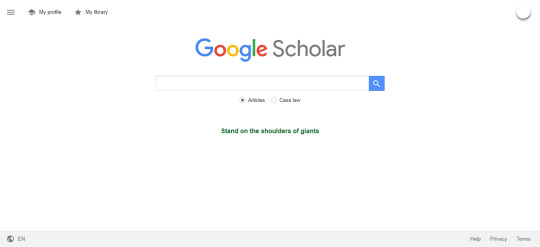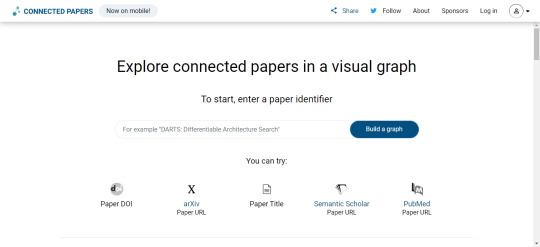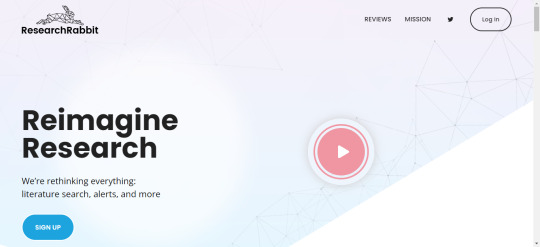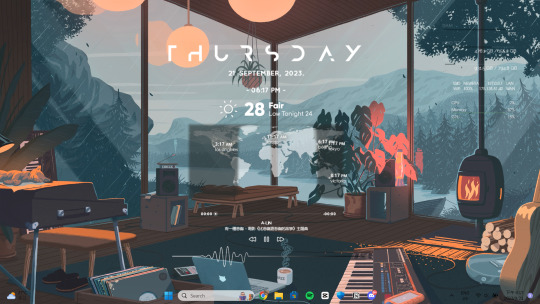#semanticscholar
Text
Which search engine is best for academic research? Hint: It's not Wikipedia

PubMed
PubMed is a free resource supporting the search and retrieval of biomedical and life sciences literature with the aim of improving health–both globally and personally.
The PubMed database contains more than 34 million citations and abstracts of biomedical literature. It does not include full-text journal articles; however, links to the full text are often present when available from other sources, such as the publisher's website or PubMed Central (PMC).
Available to the public online since 1996, PubMed was developed and is maintained by the National Center for Biotechnology Information (NCBI), at the U.S. National Library of Medicine (NLM), located at the National Institutes of Health (NIH).

Google Scholar
Google Scholar provides a simple way to broadly search for scholarly literature. From one place, you can search across many disciplines and sources: articles, theses, books, abstracts, and court opinions, from academic publishers, professional societies, online repositories, universities, and other websites. Google Scholar helps you find relevant work across the world of scholarly research.

Semantic Scholar
Semantic Scholar provides free, AI-driven search and discovery tools, and open resources for the global research community. With Semantic Scholar, researchers can understand a paper at a glance. Our system extracts meaning and identifies connections from within papers, then surfaces these insights to help Scholars discover and understand research.

Connected Papers
Connected Papers is a unique, visual tool to help researchers and applied scientists find and explore papers relevant to their field of work.

Research Rabbit
Research Rabbit is starting with our Discovery app which unlocks a completely novel way to search for papers and authors, monitor new literature, visualize research landscapes, and collaborate with colleagues.
#pubmed#google scholar#semanticscholar#research rabbit#connected papers#researchers#research paper#research#biotechnology#biotech#science#biology#biochemistry#studyblr#molecularbiology#notes#class notes#students#biotechnology science#useful information#search engines & search marketing#search engine#phd scholar#phd#phd candidate#thesis#university#grad school#phd topics#wikipedia
992 notes
·
View notes
Text
semanticscholar محرك بحث علمي ممتاز
semanticscholar محرك بحث علمي ممتاز
https://youtu.be/3dV7PQ2MXek تاكد انك مشترك في القناة 💯 ومفعل الجرس عشان يوصلك كل جديد 🔔 وما تنساش تعمل لايك للفيديو 👍
نشرك للمقطع هو اكبر دعم ممكن تقدمه لي …
أتمنى أن ينال الشرح أعجابكم
https://ift.tt/wLgJlYd
…………………………………………………………….
https://ift.tt/trsnX1m
https://ift.tt/6DgNSe0
شير مشاركة #BIMarabia
اشترك في القناة لمتابعة الشروحات…
View On WordPress
0 notes
Text
me : casually researching for scholar papers about fashion history in relation with mondialisation for a paper for my history class
semanticscholars, probs knowing i am a philosophy major :

33 notes
·
View notes
Text
˖⁺‧₊˚✦ ways to make your laptop aesthetic feat. some extensions, websites & apps for students
i created this cause i found some time to finally upgrade and properly personalise my laptop, it took me almost an entire day watching youtube videos, researching for these and setting them up. so... i'm basically posting this for myself lol, but i also feel like sharing cause these are actually really good hehe
i'm using a windows laptop but i think most of these should work on mac too. most of these are free but there are maybe like less than five that require to be paid.
those that are marked with an asterisk (*) are the ones that i'm currently using while others are recommended or alternatives!
here is what my home screen looks like now:

i. screen saver
fliqlo (ios & win) *
flipit (win, an inspired & alt ver of ^)
flix clock (mac & web, paid ver comes with colours other than black)
aura gradient clock (mac & web)
retro anime desk clock (mac)
flocus (web) *
studywithme (web)
note: remember to right-click the file and select "install", then ensure that the wait time (e.g: 5 mins) is less than your "turn off your screen" and "put my device to sleep after" (e.g: both 15 mins) in power settings
ii. tab themes
kluk: a clock tab theme *
angry study helper: a tab theme that gets angy at u whenever u open a new tab
gratitutab: a minimalistic tab theme that works as a to-do list
prioritab: a tab theme that shows priorities that u had set for the day, week, and month
iii. extensions
tldr this: summarizes long docs, websites, articles, etc. with just a click *
paperpanda: download research papers by clicking on it, it searches on domains like google scholar, semanticscholar, aodoi, and more *
coffeelings: mainly a mood tracker that also saves mini journal entries
colorzilla: an eyedropper colour picker *
whatfont: click on it and hover on any text to show what font it is *
mybib: an apa, mla, harvard, and more styles citation generator *
read aloud: a tts reader that supports more than 40+ languages *
notion web clipper: creates a website into a bookmark into notion *
noisli: lets u listen to relaxing playlist while u study/work
iv. websites
lofi.cafe
i miss the office
i miss my cafe
i miss my bar
i miss my library
a soft murmur
patatap
tomato timers
animedoro
lifeat
coolors
blush designs
untools
fontjoy
zenpen
decision maker
museum of endangered sounds
future me
v. apps
virtual cottage
chill corner
notion *
vi. rainmeter skins
mond *
lano visualizer
amatical *
small clean weather animated *
ageo
sonder *
cloudy
harmattan
note: if you're new to rainmeter, it can be a bit overwhelming, u may check out this short and simple tutorial on it, make sure to read the instructions if you're using complicated skins like weather (may require u to edit in txt), i also highly rec watching techrifle's videos
vii. misc.
wallpaper engine * (highly rec getting from chillhop)
my live wallpaper (free alt of ^)
translucenttb *
roundedtb
note: u can disable your shortcut icons to be invisible by right-clicking on your home screen, go to "view", and untick "show desktop icons", this is optional and i would always enable it whenever i'm working and gaming for easier access, i also set the icons to small
27 notes
·
View notes
Text
i love you researchgate i love you sciencedirect i love you jstor i love you pubmed i love you semanticscholar
3 notes
·
View notes
Text
Sources & Significance 1_1.11 - Critical Analysis
Part 1 - Introduction:
Initially the piece largely tasks itself with outlining what interactive narrative is. It then posits 3 core research questions:
How does a computational system determine what should happen next in the narrative?
What does a computational system need to know about the fictional world and the user in order to reason about the user's narrative experience?
How does a computational system intervene in the fictional world to bring about an engaging experience?
Part 2 - Experience Management:
Defining the issues a coherent narrative and progressing events that build off one another create, especially when viewed in potential opposition to the player's agency. We move across player introduced inconsistencies (defined as events the system is unable to build from) brought about by the player's desires to change the story, test the system or potentially even brought about unknowingly. This posits the key challenge being the balance between player immersion through their ability to affect the narrative and the system's ability to ensure a coherent narrative. The introduced solution being a digital system here called an 'Experience Manager', somewhat of an autonomous surrogate for the author. This experience manager would shape the narrative on behalf of the player (who would be unaware of the Experience Manager's existence), intervening and diverting the path of the player through a branching narrative structure and NPC interactions in accordance with the Player's agency. The Manager would manage the narrative through 'world states' and the projection of the best possible narrative given by the player's agency. The Manager would then use hard or soft constraints on the narrative structure using pre-determined aesthetic considerations. This would essentially result in a 'penning in' of the player into a narrative path determined by their own actions.
Part 3 - Taxonomy of Approaches to Interactive Media:
Here the author addresses the variety of issues that may stem from creating an interactive narrative:
Authorial Intent
Virtual Character Autonomy
Player Modelling
Point 1 (Authorial Intent) concerns itself with the degree the author's intent may constrain the interactivity of the narrative and the sense in which a system can assume the creative responsibilities of a human author.

SEMANTICSCHOLAR. [Online]. Available at: https://www.semanticscholar.org/paper/Interactive-Narrative%3A-An-Intelligent-Systems-Riedl-Bulitko/8cc0b359ac723d819be3343b20df9c6beaaa7bee
Above is a figure displaying the constraint of authorial intent by systems, with the systems on the left catering more to the author's intent and the further right we go the more we focus on the player's narrative experience.
A stronger author's intent can ensure the quality of the experience (at least in accordance with the author's expression, potentially leading to greater immersion through a hand-crafted narrative). While greater emphasis on the narrative system increases greater agency for the player (potentially leading to greater immersion through interactivity). At the strong authorial intent end of the interactivity spectrum we find Choose-Your-Own-Adventure and related game systems. In these games the player usually moves from node to node on a branching story graph. Branches representing player choices, while the nodes are manually-authored sections of text as response to the designated choices. As more user interaction is added, there is the danger that these graphs go beyond human calculation and it becomes the experience manager's job to assume greater decision making authority. These can be managed through a Plot-Graph (a map of possible narrative trajectories) reacting to the player's actions through constraints placed on scenarios and can even nudge the player through direct interaction in the form of tutorials or hints. The author's intent now present more through the design of the Experience Manager and it's ability to determine and manage the trajectory of the story. The further we move along the spectrum the more total the experience manager's role in crafting a satisfying narrative becomes. This is the territory of generative experience management in which the Author's involvement in the narrative is much more general while the manager is responsible for generating the narrative. It may manage the experience through domain theory (a declaration of what is and isn't possible) and the world state (conditions that allow or disallow certain conditions) without any pre-determined understanding about the order in which changes occur. Through this system the experience manager will sooner or later encounter the 'boundary problem' (recognition and response to a player's attempts to deviate from the intended narrative). The Experience Manager is likely to respond to the Boundary Problem through intervention (an act by the experience manager that will prevent the player from crossing the narrative boundary) or accommodation (allowing the deviation to occur and creating a new narrative that eliminates any inconsistencies).
-
Point 2 (Virtual Character Autonomy) concerns the autonomy of NPCs within the system's framework. It strives to investigate the balance between an NPCs ability to act consistently within their own character while also staying true to the needs of the narrative.
This is an integral part of character believability (how easy it is for the player to suspend their disbelief that this is a personality-driven, intelligent being). This is apparent in the way the Character interacts with the environment and the player. While characters are an integral part of every story they can be at odds with the structure and systems. This paper posits two opposing key views. A focus on Strong Story: where virtual characters do not act without the guidance and permission of the experience manager. or Strong Autonomy: In which virtual characters are fully autonomous agents, untethered by the needs of the overarching narrative. Interactive narratives tend to fashion their NPCs in-between these two extremes. A strong story focus will allow the experience manager high leverage over the virtual world, able to act as needed to break down plot points into performable actions as necessary. While a strong autonomy focus will create a user experience driven by the actions of NPCs. This is referred to as an emergent narrative. This is particularly synonymous with Simulation games. Which usually do not require intervention and have much looser guidance from the experience manager.
Most interactive systems try to strike a middle ground. The paper posits The Façade as an example of a interactive experience that addresses this through the breaking down of larger plot-units into executable behaviours, with the experience manager providing coherence. The NPCs autonomously determine how the plot points are realised. Similarly The Automated Story Director is mentioned as an example of fully autonomous NPCs that are directed by the experience manager when required to ect in the interest of plot progression.
-
Point 3 (Player Modelling) regards the extent to which the system attempts to learn and react to the individual differences of each Player. Player models are considered abstractions blanketing the pattern of behaviour displayed by the player. This subsequently allows the system to tailor and manage the player's experience.
Different players will have differing preferences of how their narrative progresses. The experience manager may take this into account and predict a Player's narrative future, forming an abstract 'model' of the player's individual tendencies and preferences through a learning process. In this case particularly focused on preserving the author's intent. This process may be applied in order for NPCs to adapt behaviour or as justification for the experience manager to intervene for the player's benefit.
Part 4 - Discussion
The paper then posits 5 major open-ended questions:
How and when should [the experience manager] intervene in the virtual world on behalf of the user?
How will [the experience manager] generate narrative structures?
How would [the experience manager] encode human authorial intent and at what level of abstraction?
How would [the experience manager] incorporate believable characters into an interactive narrative framework?
How would [the experience manager] tailor narrative experiences?
0 notes
Text
wow i was looking for a specific pdf and wondering why i was having so much trouble finding it, and, look at this shit

on google the first one looks like it could at least be the correct paper but it isn’t, the second one is unrelated, the third one is the correct pdf on semanticscholar, the direct bmj link is nowhere to be found, the rest of the results are random unrelated bullshit

and then on duckduckgo the first one is the correct link, and some of the rest are even vaguely related
0 notes
Text
Activity 2
1. Walk Cycles: Walk cycles are a form of cycle animation that showcase a repetitive walking action through a series of frames drawn in sequence (Codrina, “Cycle Animation”). The animation progresses through four main poses: contact, recoil, passing, and high point (“Walk_Cycle”). Walk cycles were originally hand drawn and used in film animation to move characters from point A to point B (“Advanced Digital Animation”). This is explained further in Disney’s book, The Illusion of Life, which depicts how Disney utilized cycle animations to display continuous movement, and capture and convey emotion in the characters.

“Walking Pig.” Giphy. https://giphy.com/gifs/tonkohouse-walking-pig-tonko-house-LSvIMP9qLyovwME3aa. Accessed 25 Sept. 2020

“Abstract Fire Walker.” Giphy. https://giphy.com/gifs/trippy-fire-abstract-l3vQX3n7rkK7Dpg64. Accessed 25 Sept. 2020
Wigglegram: Wigglegrams are animated images that appear to be 3D through looping two or three frames of an object (“Wigglegrams”). The image appears to wiggle back and forth between two images, hence the name, wigglegram. They are also known as stereographs and can be compared to cinemagraphs in the sense that they both consist of a few looped continuous frames. Wigglegrams originated in 2002 when Jim Gasperini, a Califorinian interaction designer, uploaded a series of GIFs of “wiggling scenes” between right and left images from stereographs he had previously taken (“Wigglegrams”). Wigglegrams are effective in creating the perception of depth, yet they often drown out important details in the images due to the constant motion (“Wiggle Stereoscopy”).

Salim, Adam. “Looting Black Lives Matter.” Giphy. https://giphy.com/gifs/black-lives-matter-dont-hate-learn-to-love-l4YE3s0SyMRs0ZL8qi. Accessed 25 Sept. 2020.

“Black and White Falling GIF.” Giphy. https://giphy.com/gifs/vintage3d-black-and-white-vintage-trippy-DXbmubAYq8V32. Accessed on 25 Sept. 2020.
4. Frame-capture GIFs display and repeat a scene from movies, television shows, newscasts, etc (Giampaolo, “GIFABILITY”). They capture pop cultural moments and play them in an endless loop. They are important because they retain a sense of their origin, i.e. the movie the particular GIF scene was pulled from, while also becoming their own “badge of pop culture” (Giampaolo, “GIFABILITY”). Artist GIFs on the other hand, can also be sourced from movies, however, they are higher in resolution and focus on high level detail; capturing aesthetic moments rather than pop cultural moments. The “poor” images found in frame-grab GIFs have more credibility as they can be easily produced and seen by greater groups of people compared to higher resolution images (Hito, "In defense of the poor image"). Poor images invite and encourage manipulation, editing, resharing, etc., without the need of crediting authorship.
Works Cited
“Advanced Digital Animation.” SemanticScholar. https://pdfs.semanticscholar.org/bf9e/8c9dc7c45b125a7db60d51de53de53d46f00.pdf. Accessed 25 Sept. 2020.
“Walk_Cycle.” Ludowalsh. www.ludowalsh.com/HTM/walk_cycle.html#:~:text=A walk cycle can be,four is the contact pose. Accessed 25 Sept. 2020.
Codrina. “Cycle Animation - What Is It?” Marionette Studio, 3 Mar. 2018, marionettestudio.com/what-is-a-cycle-animation/. Accessed 25 Sept. 2020.
Bianconi, Giampaolo. “GIFABILITY.” Rhizome, 20 Nov, 2012, rhizome.org/editorial/2012/nov/20/gifability/. Accessed 25 Sept. 2020.
Steyerl, Hito. "In defense of the poor image." e-flux journal 10.11 (2009). Accessed 25 Sept. 2020.
“Wiggle Stereoscopy.” Wikipedia, Wikimedia Foundation, 24 Aug. 2020, en.wikipedia.org/wiki/Wiggle_stereoscopy. Accessed 25 Sept. 2020.
“Wigglegrams.” Know Your Meme, 15 Sept. 2020, knowyourmeme.com/memes/wigglegrams. Accessed 25 Sept. 2020.
0 notes
Photo

"[P] MLG v2 - Visual Machine Learning Graph of all arXiv papers and researchers"- Detail: Hey everyone,After receiving a lot of feedback from you (thanks!), I rebuilt my project - a visual network of Machine & Deep Learning papers. You can now search for any paper or author and start wandering through their references and citations (and through theirs and so on...). Once you expanded a few nodes you can re-arrange the network and see some interesting connections between nodes.http://bit.ly/2C37lbe project is based on data from arXiv and SemanticScholar. It's open source of course, and I hope that people would add some interesting algorithms to it, such as clustering, coloring, etc.Code: http://bit.ly/2R8YWgF love to hear your opinion :). Caption by ranihorev. Posted By: www.eurekaking.com
0 notes
Text
lifehack.org | 50 Self-Affirmations to Help You Stay Motivated Every Day
lifehack.org | 50 Self-Affirmations to Help You Stay Motivated Every Day
mukeshbalani.com | “You heard it here first…if you haven’t already heard it elsewhere”…
50 Self-Affirmations to Help You Stay Motivated Every Day
Contrary to popular belief, a self affirmation will work to motivate you, but there’s a catch: it is only effective if you have high self-esteem.
According to a 2009 study,((SemanticScholar: Positive self-statements: power for some, peril for others))…
View On WordPress
0 notes
Text
> #### F-Droid is a Key Source for Academics and Researchers > Posted on Mar 4, 2020 by eighthave eighthave > https://f-droid.org/en/2020/03/04/f-droid-is-a-key-source-for-academics-and-researchers.html > > We rarely hear from academics and researchers, but we know that F-Droid is important to their work because they cite F-Droid as a source in so many papers: > > - arXiv lists more than 200 results > - Semantic Scholar lists more than 200 results > - Google Scholar lists more than thousand results > > Here are a couple that we found particularly interesting: (...) > → https://f-droid.org/en/2020/03/04/f-droid-is-a-key-source-for-academics-and-researchers.html
#News from the very interesting: https://f-droid.org/en/news/
#fdroid #f-droid #opensource #freesoftware #freesw #softwarelibre #academy #sciences #research #android #gnu #gpl #fsf #fsfe #arxiv #openscience #semanticscholar #googlescholar #google #papers #development #code
original post
0 notes
Quote
And @allen_ai @kaggle @SemanticScholar initiatives around academic research on coronavirus https://t.co/zxfO5d1RBA
http://twitter.com/storybench
0 notes
Video
youtube
semanticscholar محرك بحث علمي ممتاز تاكد انك مشترك في القناة 💯 ومفعل الجرس عشان يوصلك كل جديد 🔔 وما تنساش تعمل لايك للفيديو 👍 نشرك للمقطع هو اكبر دعم ممكن تقدمه لي ... أتمنى أن ينال الشرح أعجابكم https://bit.ly/3Bl7q8L ...................................................................... https://bit.ly/3N9F3OH https://bit.ly/3ux7pwI شير مشاركة #BIMarabia اشترك في القناة لمتابعة الشروحات الجديدة videos https://www.youtube.com/channel/UCZYaOLTtPmOQX1fgtDFW52Q?sub_confirmation=1 بيم ارابيا https://bit.ly/1TSqEbr ❤️ رابط الاشتراك في القناة https://www.youtube.com/channel/UCZYaOLTtPmOQX1fgtDFW52Q?sub_confirmation=1 ❤️ روابط التواصل ✅ انستجرام https://bit.ly/2JY3wZP ✅ الفيسبوك https://bit.ly/3AcrQBO ✅ تويتر https://twitter.com/bimarabia ✅ لينكد ان https://bit.ly/2nqASDv ✅ قناة التلجرام https://bit.ly/3bu9Pod ✅ الموقع الالكتروني الشخصي https://bit.ly/3N9F3OH Skip to search formSkip to main contentSkip to account menu OMAR SELIM A free, AI-powered research tool for scientific literature Search 206,238,081 papers from all fields of science Search Try: Kiho Kim Economic Growth Sigma Bonds Stay Connected With Semantic Scholar Your E-mail Address Sign Up What Is Semantic Scholar? Semantic Scholar is a free, AI-powered research tool for scientific literature, based at the Allen Institute for AI. Learn More About About Us Publishers Blog(opens in a new tab) Careers(opens in a new tab) Product Beta Program S2AG API Semantic Reader Research Team Publications Resources Help FAQ Librarians Tutorials Contact Proudly built by AI2(opens in a new tab) Collaborators & Attributions•Terms of Service(opens in a new tab)•Privacy Policy(opens in a new tab) The Allen Institute for AI(opens in a new tab) https://bit.ly/3suwyqU https://bit.ly/3bEr3zh September 16, 2022 at 08:32AM by Omar Selim BIMarabia عمر سليم بيم ارابيا
0 notes
Text
A tweet
6 innovative new #search engines#Oscobo #GoodGopher #SemanticScholar #Yippy #Omnity https://t.co/7GzsAHYz11#tech #science #research
— Ted @ERGOSEO (@ergoseo) December 4, 2017
0 notes
Text
semanticscholar موقع مهم للبحث العلمي
https://youtu.be/SV8TmVxUGfE
أهلاً بكم متابعينا الأعزاء، نود أن نشكركم على مشاهدة فيديونا ونأمل أن يكون قد نال إعجابكم. يرجى النقر على زر الإعجاب والاشتراك في القناة ليصلكم كل جديد.
https://ift.tt/Kv2FPO0
نشرك للمقطع هو اكبر دعم ممكن تقدمه لي …
أتمنى أن ينال الشرح أعجابكم
…………………………………………………………….
https://ift.tt/yNjaVpK
https://ift.tt/qQuWhoE
شير مشاركة #BIMarabia
اشترك في القناة لمتابعة الشروحات الجديدة
videos
https://www.youtube.com/channel/UCZYaOLTtPmOQX1fgtDFW52Q?sub_confirmation=1
بيم ارابيا
http://bimarabia.com/

رابط الاشتراك في القناة
https://www.youtube.com/channel/UCZYaOLTtPmOQX1fgtDFW52Q?sub_confirmation=1

روابط التواصل

انستجرام
https://ift.tt/Yfv80Hp
وإذا كنت ترغب في دعم القناة، يمكنك شراء لنا فنجان قهوة عبر الرابط التالي:
https://ift.tt/qjDXado

الفيسبوك
https://ift.tt/ouTr6ih

تويتر
Tweets by BIMarabia

لينكد ان
https://ift.tt/KhrznvJ

قناة التلجرام
https://t.me/bimarabia1

الموقع الالكتروني الشخصي
https://ift.tt/yNjaVpK
https://ift.tt/GbLeV29
https://ift.tt/0xK3wRi
augmented reality
youtube
open source مفتوحة المصدر
youtube
revit workshop ورشة عمل ريفيت
youtube
OPEN STREET MAP
youtube
المدن الذكية
youtube
الاستدامة
youtube
الذكاء الاصطناعي
https://www.youtube.com/watch?v=UWmW84ZBrbg&list=PLNMim060_nUJs5lSTwbFK8Pe1BCUPT_EB
youtube
source https://bimarabia.com/OmarSelim/semanticscholar-%d9%85%d9%88%d9%82%d8%b9-%d9%85%d9%87%d9%85-%d9%84%d9%84%d8%a8%d8%ad%d8%ab-%d8%a7%d9%84%d8%b9%d9%84%d9%85%d9%8a/
0 notes
Text
semanticscholar موقع مهم للبحث العلمي
via IFTTT
source https://bimarabia.com/OmarSelim/semanticscholar-%d9%85%d9%88%d9%82%d8%b9-%d9%85%d9%87%d9%85-%d9%84%d9%84%d8%a8%d8%ad%d8%ab-%d8%a7%d9%84%d8%b9%d9%84%d9%85%d9%8a-2/
0 notes